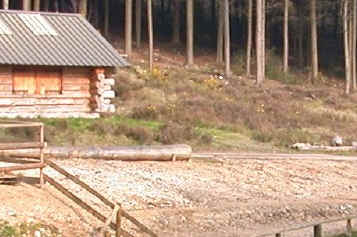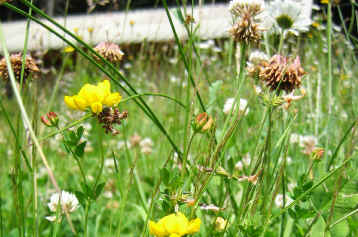| By the time two years have passed, succession has
already taken place on our bare patch of ground. A new community of plants, animals, fungi
and micro-organisms has largely replaced the earliest pioneer species which first
colonized the bare ground. The environmental conditions on the same patch of ground are
considerably different to the conditions present when the first pioneers arrived.
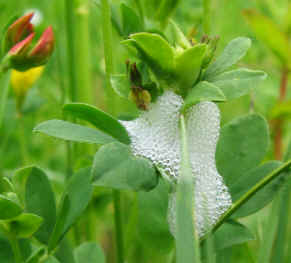 |
By now, a variety of
longer-lived, slower colonizers have displaced many of the species in the early pioneer
community. These include grasses and flowering herbs such as dock, clover and Bird's-foot
Trefoil. The ground is almost completely covered in plants. The
plants are not the only species to have colonized the area. Along with the plants have
come the herbivorous invertebrates which feed on those particular plant species. The
presence of the herbivores then attracts a range of carnivorous invertebrates to feed on
them.
Left: 'Cuckoo Spit' - the foamy home of the young
stage of a herbivorous insect known as a Froghopper. On Birds's-foot Trefoil.
See inside the 'spit'. |
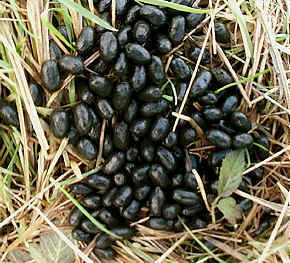 |
Larger herbivores such as
rabbits and deer will also graze such an area. Their dung
provides another wonderful microhabitat for many different species of fungi and
invertebrates. Nothing is wasted in nature and one animal's waste is another's food
source!
The soil will be enriched as the dung is recycled by the
dung-dwelling community. Interestingly, the dung community also goes through a succession
of its own as the droppings age.
Left: Roe Deer droppings |
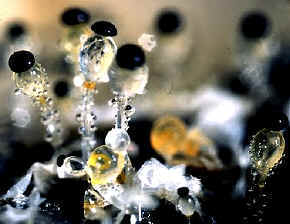 |
One of the
fungi occurring in various types of animal dung is called Pilobolus. The
fruiting bodies are produced on the surface of the dung (left). It has a
fascinating method of ensuring that it is always in the right place at the right time. The fruiting bodies are only 3mm high, with a little black
packet of spores on the top. The bulb beneath the spore packet explodes shooting
the packet of spores out onto surrounding grass. Another animal will come along and eat
the grass together with the spores. These then pass through the gut of the animal and out
in the dung, where the fungus can then develop all over again. |
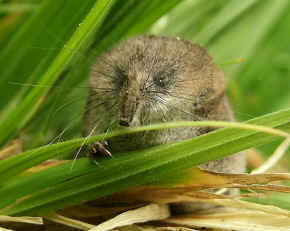 |
A number of small mammals
will also now be present, including shrews (left), voles and mice. These will attract carnivores such as owls and foxes to
feed on them.
Because there are now many more species of plants and animals in the
area, the number of possible interactions between species has greatly increased.
The simple food chains of the eariest pioneer stage, when few
species were present, have developed into more complex foodwebs.
|
Many, if not all of the environmental changes which have taken place
on our original bare area have actually been brought about by the communities living
there. This is because in the processes of living, growing and reproducing, species
interact with and modify their habitat.
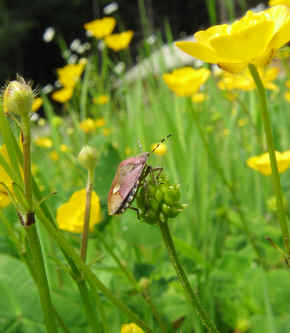 |
Using our previous example to illustrate this, the
grasses and small flowering herbs have by now bound the bare soil with their network of
roots, preventing erosion and soil loss. The soil has been somewhat enriched through the
addition of dung and the decomposition of dead plants. Legumes such as the clover and
trefoil will also have helped to add nutrients to the soil through nitrogen fixation in
their root nodules.
The cover provided by the vegetation has affected the
microclimate of the ground surface, while also providing a great variety of microhabitats
for invertebrates.
Left: Shield Bug on buttercup |
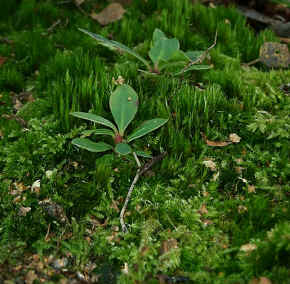 |
The environmental changes brought about by organisms often result in their
subsequent elimination from the area. For example, pioneering
mosses may grow into thick cushiony carpets with great water-holding capacity, which act
like sponges. These provide an ideal new environment for the germination and establishment
of the seeds of other competing plants, which otherwise might die from lack of water.
These rhododendron seedlings (left) will eventually grow into tall, tangled, dark thickets which will shade out
and displace the moss which enabled them to survive in the first place. (Note : Rhododendron ponticum is not native to Britain and causes great ecological damage.) |
In the space of two years, the biodiversity (variety of life) on our
bare patch of ground has soared, as it has been colonized by fungi, plants and animals.
The ecosystem has developed from a very simple one with few interactions, to a much more
complex system with a staggering number of interactions going on between individuals,
species and the habitat itself.
If left undisturbed, the area will pass through a number of further
different successional stages, each with its own characteristic mix of species. All of
these different successional stages are known collectively as a sere.
Each new community will be better adapted to the changed environment
which has been provided by the previous community.
Eventually, a climax or 'final' community is reached.
At this point, the succession will not go any further. However, this does not imply that
there will be no further change.
 |
The climax community for our original bare patch of
earth would be oak woodland. As part of the natural sequence
of life, trees mature and eventually die. When they fall to the ground, an opening is
provided in the woodland and the process of succession will start all over again on this
new opening.
The species which colonize the opening will be different to the
original bare ground pioneers because the environmental conditions have been altered. |
Because there is a different starting point, this cycle
of succession would be known as a secondary succession.
It differs from the succession which first started on
our original bare patch of ground, because this had never been colonized before. This
first succession is therefore known as a primary succession.
Follow a succession starting in water, otherwise
known as a
Hydrosere
If you are not on Broadband,
this next page may take longer
to download because it includes many images. |
